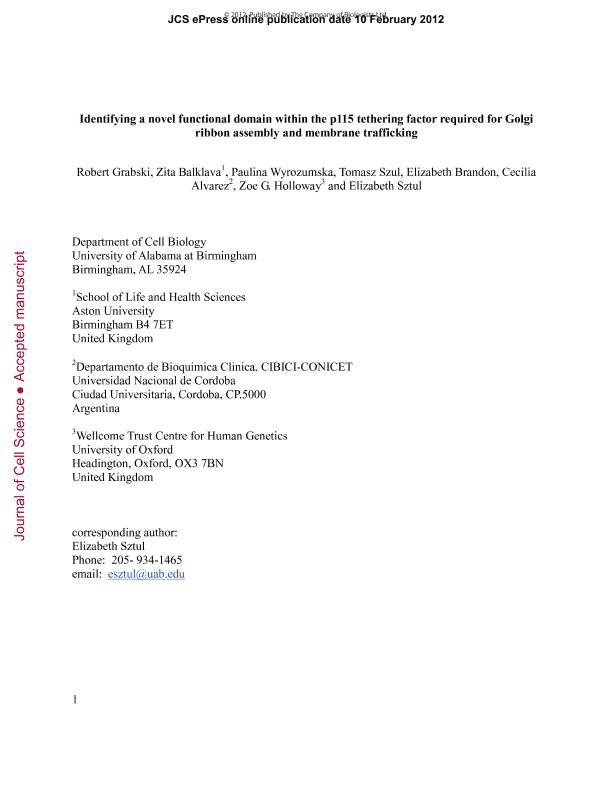Artículo
Identification of a functional domain within the p115 tethering factor that is required for Golgi ribbon assembly and membrane trafficking
Grabski, Robert; Balklava, Zita; Wyrozumska, Paulina; Szul, Tomasz; Brandon, Elizabeth; Alvarez, Cecilia Ines ; Holloway, Zoe G.; Sztul, Elizabeth
; Holloway, Zoe G.; Sztul, Elizabeth
 ; Holloway, Zoe G.; Sztul, Elizabeth
; Holloway, Zoe G.; Sztul, Elizabeth
Fecha de publicación:
02/2012
Editorial:
Company of Biologists
Revista:
Journal of Cell Science
ISSN:
0021-9533
e-ISSN:
1477-9137
Idioma:
Inglés
Tipo de recurso:
Artículo publicado
Clasificación temática:
Resumen
The tethering factor p115 (known as Uso1p in yeast) has been shown to facilitate Golgi biogenesis and membrane traffic in cells in culture. However, the role of p115 within an intact animal is largely unknown. Here, we document that depletion of p115 by using RNA interference (RNAi) in C. elegans causes accumulation of the 170 kD soluble yolk protein (YP170) in the body cavity and retention of the yolk receptor RME-2 in the ER and the Golgi within oocytes. Structure–function analyses of p115 have identified two homology regions (H1 and H2) within the N-terminal globular head and the coiled-coil 1 (CC1) domain as essential for p115 function. We identify a new C-terminal domain of p115 as necessary for Golgi ribbon formation and cargo trafficking. We show that p115 mutants that lack the fourth CC domain (CC4) act in a dominant-negative manner to disrupt Golgi and prevent cargo trafficking in cells containing endogenous p115. Furthermore, using RNAi of p115 and the subsequent transfection with p115 deletion mutants, we show that CC4 is necessary for Golgi ribbon formation and membrane trafficking in cells depleted of endogenous p115. p115 has been shown to bind a subset of ER-Golgi SNAREs through CC1 and CC4 domains (Shorter et al., 2002). Our findings show that CC4 is required for p115 function, and suggest that both the CC1 and the CC4 SNARE-binding motifs participate in p115-mediated membrane tethering.
Palabras clave:
P115
,
Trafficking
,
Golgi
Archivos asociados
Licencia
Identificadores
Colecciones
Articulos(CIBICI)
Articulos de CENTRO DE INV.EN BIOQUI.CLINICA E INMUNOLOGIA
Articulos de CENTRO DE INV.EN BIOQUI.CLINICA E INMUNOLOGIA
Citación
Grabski, Robert; Balklava, Zita; Wyrozumska, Paulina; Szul, Tomasz; Brandon, Elizabeth; et al.; Identification of a functional domain within the p115 tethering factor that is required for Golgi ribbon assembly and membrane trafficking; Company of Biologists; Journal of Cell Science; 125; 8; 2-2012; 1896-1909
Compartir
Altmétricas



